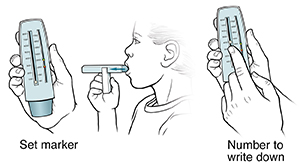A
B
C
D
E
F
G
H
I
J
K
L
M
N
O
P
Q
R
S
T
U
V
W
X
Y
Z
Click a letter to see a list of conditions beginning with that letter.
Click 'Topic Index' to return to the index for the current topic.
Click 'Library Index' to return to the listing of all topics.
Your Child’s Asthma: Peak Flow Monitoring
You can monitor your child's asthma symptoms by closely watching for early changes or by using a peak flow meter. A peak flow meter is a tool for testing how well your child’s lungs are working. It can help warn you of a flare-up, even before your child has symptoms. Make sure you know when you and your child should check their peak flow. And make sure that you and your child know how to use the meter correctly.
Your child's provider may want you to keep a diary of your child's peak flow monitoring results. The provider may use this information to make changes to your child's medicine or Asthma Action Plan.
The peak flow meter
A peak flow meter measures how much air your child can quickly push out of the lungs. This helps show how open the child’s airways are at that moment. Your child’s peak flow meter may look different from the one shown here. But it will work in a similar way.
Steps for checking peak flow:
-
Move the marker to 0 or the lowest number on the scale. Have your child stand if possible. Ask your child to take as deep a breath as possible.
-
Put the mouthpiece of the meter in your child's mouth. Ask your child to close their mouth around the mouthpiece.
-
Have your child keep their tongue away from the opening of the device.
-
Ask your child to blow into the mouthpiece once, as hard and fast as possible.
-
Remove the meter from your child's mouth.
-
Check where the marker has moved on the numbered scale. Write down this number. Move the marker back to 0 and repeat the test 2 more times. The highest number from the 3 tests is your child’s peak flow.

What is the personal best?
Your child’s personal best is their highest peak flow number during a week or two when they are not having symptoms. Other peak flow results are compared to the personal best. This helps show how your child is doing over time.
What do peak flow numbers mean?
A peak flow number lower than 80% of the personal best may signal a flare-up. Keep in mind that peak flow can vary from day to day. Other factors may also affect peak flow:
-
Age. Lungs grow as a child grows. So, the personal best should increase as your child gets older.
-
Control. The personal best may increase once asthma is in control.
-
Poor effort. Make sure your child takes a deep breath and breathes out (exhales) as quickly and as hard as possible.
Peak flow monitoring: Color zone system
-
Green = Good. Airflow score is 80% to 100% of your child's personal best. No changes needed in your child's treatment or activities.
-
Yellow = Caution! Airflow is 50% to 80% of your child's personal best. Based on your child's Asthma Action Plan, more medicine or actions are needed.
-
Red = Danger! Airflow is less than 50% of your child's peak flow. Take action based on your child's Asthma Action Plan. Call your child's healthcare provider, go to the ER, or call 911 if the peak flow readings stay below 50% even after treatments.
Your child's healthcare team can help you calculate your child's ranges.
Online Medical Reviewer:
Amy Finke RN BSN
Online Medical Reviewer:
Deborah Pedersen MD
Online Medical Reviewer:
Jessica Gotwals BSN MPH
Date Last Reviewed:
10/1/2022
© 2000-2024 The StayWell Company, LLC. All rights reserved. This information is not intended as a substitute for professional medical care. Always follow your healthcare professional's instructions.